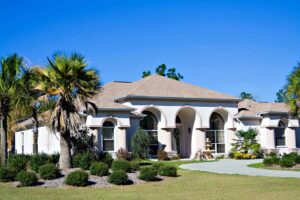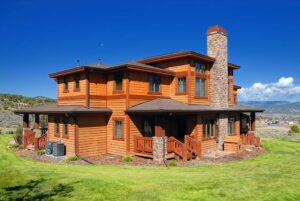As wildfire season looms, homeowners in states like California, Colorado, Arizona, and Oregon – areas notoriously prone to wildfires – face the daunting challenge of safeguarding their properties against these unpredictable and devastating forces of nature. Ensuring the resilience of your home’s first line of defense, the roof, becomes a paramount concern in these regions. Gunner Roofing provides essential tips and strategies for homeowners across these wildfire-susceptible states to fortify their roofs against the ravaging flames of wildfire season.

Understanding the risk
Wildfires, with their capacity to ignite and spread swiftly, pose a significant threat, especially given their ability to carry embers across long distances to vulnerable targets like residential roofs. These roofs, often the first point of contact for airborne embers, can easily catch fire if made from non-fire-resistant materials, leading to potential property loss and danger to inhabitants. Recognizing this risk is crucial for homeowners in wildfire-prone areas, like those in the western United States, necessitating a proactive approach in selecting fire-resistant roofing materials and maintaining a debris-free environment. This preparation is not just advisable; it’s a critical safeguard for the protection of homes and families against the unpredictable ferocity of wildfires.
Choosing fire-resistant roofing materials
The choice of roofing materials is crucial in fortifying your home against wildfires, with the roofing industry offering materials rated for their fire-resistance, such as Class A fire-rated asphalt shingles, metal roofing, and clay and concrete tiles. These fire-resistant roofing materials are designed to withstand not just light or moderate fire exposure but also severe to extreme fire conditions, ensuring superior protection from flying embers and intense heat that can originate from wildfires.
- Asphalt shingles: Recognized for their cost-effectiveness and durability, fiberglass-reinforced asphalt shingles installed by Gunner are a standout option for homeowners in fire-prone areas. Enhanced with fire-retardant chemicals, GAF shingles – used by Gunner Roofing – offer a high level of fire-resistance, making them an ideal roofing material for homes in states like California, Colorado, Arizona, and Oregon, where wildfire damage is a significant concern. This choice not only meets but exceeds stringent fire-safety standards, ensuring that your roof deck and entire roofing system are well-equipped to resist the spread of fire.
- Metal roofing: Metal roofing systems are renowned for their fire-resistance, not supporting combustion, thereby reducing the risk of fire spreading. Their resilience against severe fire exposure, coupled with minimal maintenance requirements and the ability to withstand high heat, makes metal roofs a wise investment for those seeking long-term, fire-resistant roofing solutions.
- Clay and concrete tiles: Offering unparalleled fireproof qualities, clay and concrete tiles are among the most fire-resistant roofing options available. Though the installation of these tile materials may require additional structural support due to their weight and despite the potential for higher maintenance costs to address issues like cracking or moisture absorption, the fire protection they offer makes them a valuable choice for homes at risk of wildfire damage.
The architecture of your roof, including a simpler design with fewer recesses, and regular maintenance, such as cleaning off flammable debris and trimming overhanging branches, are vital components of a comprehensive fire-defense strategy. Ensuring your roof coverings are made from noncombustible materials or treated with fire-retardant chemicals can significantly increase your home’s resilience against wildfires. By adopting these practices along with choosing fire-resistant underlayment and materials that have undergone rigorous testing – like the intermittent flame test to simulate exposure to burning debris – homeowners can significantly enhance their roof’s fire-resistance.
Gunner services the western United States, utilizing fire-resistant materials such as GAF shingles to underscore the importance of a multilayered approach to fire prevention. Through the selection of appropriate roofing materials, adherence to fire-resistant design principles, and diligent maintenance, homeowners can effectively reduce the risk of wildfire damage, ensuring their roof acts as a formidable barrier against the threat of fires.

Installing protective additions
In addition to selecting the right materials and design for your roof, incorporating extra protective measures can significantly enhance your home’s defense against wildfires. Installing noncombustible gutter covers is a proactive step to prevent the accumulation of flammable debris in your gutters, which could otherwise ignite from airborne embers. For homes with open eaves, the use of fire stops is highly recommended. These devices block embers from entering the attic or crawl spaces, areas where fire can easily spread unseen. Furthermore, applying fire-retardant treatments to your roof can boost its fire-resistance. It’s important to note, however, that these treatments are not permanent solutions and may require periodic reapplication to maintain their effectiveness. Together, these additional measures form a comprehensive strategy to safeguard your home against the threat of wildfires.
Embracing a fire-wise landscape
Your landscaping can either fuel a fire or help defend your home. Opt for fire-resistant plants and materials, and maintain a defensible space around your home. This space acts as a buffer, slowing or stopping the spread of fire to your home. It also provides a safe area for firefighters to work.
- Zone 1 (0-5 feet from your house): Use nonflammable landscaping materials like gravel or stone. Avoid using mulch, which can easily ignite.
- Zone 2 (5-30 feet from your house): Plant low-growing, fire-resistant plants, and keep trees and shrubs well-pruned.
- Zone 3 (30-100 feet from your house): Thin trees and create breaks in vegetation to disrupt the path of a wildfire.
Community and emergency preparedness
Collaborating with your community enhances wildfire preparedness through collective efforts and resource sharing. Engaging in community programs that focus on reducing wildfire risks, such as communal cleanups and educational workshops, strengthens neighborhood safety. Additionally, creating a detailed emergency plan, including evacuation routes and a communication strategy, ensures that family members and neighbors are well-informed and ready to act in case of a wildfire. This collective approach not only improves individual household safety but also fosters a supportive and resilient community environment against wildfires.

Insurance and documentation
Ensuring your homeowner’s insurance includes wildfire coverage is crucial for financial protection in wildfire-prone areas. It’s important to review your policy for comprehensive coverage that includes the structure and contents of your home as well as living expenses during repairs. To facilitate insurance claims, document and photograph your home and belongings, creating an inventory that details their value. Store these records securely, preferably in digital cloud storage or an off-site location, to safeguard them against loss or damage. This preparation simplifies the claims process, helping you recover and rebuild more efficiently after a wildfire.
Conclusion
As wildfire season intensifies across wildfire-prone states like California, Colorado, Arizona, and Oregon, homeowners find a formidable partner in Gunner Roofing. By utilizing fire-resistant roofing materials, such as GAF asphalt shingles, Gunner helps fortify homes against the severe fire exposure characteristic of wildfires. These materials, known for their high fire rating and ability to withstand intense fire exposure without catching fire, are essential in crafting a fire-resistant roof deck that offers superior fire protection.
Key to enhancing your home’s defense against wildfires is the selection of roofing materials that offer the best in fire-resistance. Metal roofs and clay tiles, for example, are celebrated for their ability to resist the high heat and flying embers typical of wildfires, acting as noncombustible materials that safeguard your attic space and roof structure. Additionally, fire-resistant underlayment and the application of fire-retardant chemicals to roofing materials such as synthetic roofing or composition shingles can significantly boost your roof’s ability to withstand light to moderate fire exposure.
Gunner’s commitment extends beyond just the installation of fire-resistant roofing systems; it also encompasses advising homeowners on fire-prevention measures, such as regular roof maintenance to remove combustible debris and the implementation of fire-wise landscaping. These steps, combined with community-wide emergency preparedness efforts, underscore a holistic approach to minimizing wildfire damage.
Yet it’s vital to recognize that while these strategies, from employing Class A fire-rated roofing materials to designing roofs to resist extreme heat, can drastically lower the risk of wildfire damage, they cannot offer complete immunity against the unpredictability of wildfires. Continuous vigilance, adaptation, and a commitment to adopting these fire-safety practices are crucial. Gunner Roofing is dedicated to supporting homeowners in the western United States, ensuring that each roof – your home’s primary shield against wildfires – is optimally prepared for fire season. Together, embracing these comprehensive fire-resistance strategies ensures our homes, communities, and families receive the highest level of protection possible against the threat of wildfires.